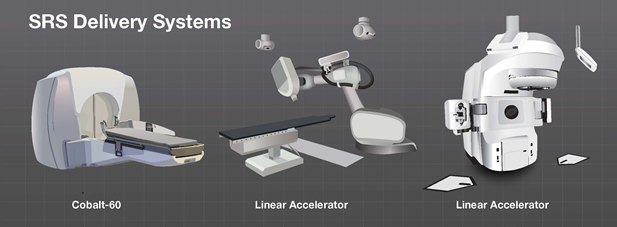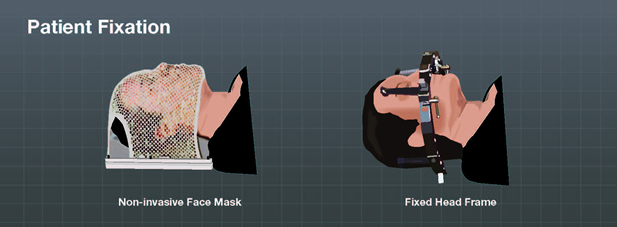Delivery Systems and Techniques for Stereotactic Radiosurgery

SRS can be delivered with different systems such as linear accelerators, also called LINACs (including robotic systems) and Cobalt-60 systems.
Cobalt-60 systems deliver radiation beams via 201 circular pinholes in a fixed helmet worn by the patient. The pinhole radiation meets or converges, at the tumor site delivering a high dose while the surrounding healthy tissue and critical brain structures receive minimal radiation. These systems offer treatment options with proven effectiveness and high precision.
Linear accelerators also offer radiation in a circular shape much like the cobalt-60 systems. As the linear accelerator rotates around the patient’s head in an arc, narrow circularly shaped beams are delivered to the tumor. The tumor is positioned at the center of the rotational arc so that the healthy tissue surrounding the tumor is exposed only once and only momentarily to the radiation as the system rotates around the patient’s head.
While the cobalt-60 and linear accelarator systems differ, the dose distribution achieved with the spherical radiation is equivalent.
Beam Shaping Technique
Linear accelerator systems can offer another advanced delivery technique using ‘shaped beams.’ When a LINAC is equipped with special hardware that mimics the shape of the tumor, the system can deliver highly precise shaped radiation as the system rotates around the patient’s head.
By mimicking the shape of the tumor, doctors can program a LINAC to deliver a maximum dose of radiation evenly to the entire tumor while protecting surrounding healthy tissue. The typical brain tumor has a different shape when looked at from different angles around the head. The LINAC is programmed to modify the shape of the treatment beam continuously during rotation so that it always matches the tumor shape from any angle.
Patient Fixation and Non-Invasive Radiosurgery Options

Both cobalt-60 and linear accelerators traditionally require the patient’s head to be secured for treatment with an invasive head frame that is attached to the skull using sharp-tipped screws.
While the head frame is still widely used and effective, a frameless option using a non-invasive, personalized mask is now the state-of-the-art alternative for LINAC-based stereotactic radiosurgery. Given the nature of the non-invasive masks, there is potential for patient movement, but this is tracked and compensated for by the system’s positioning and monitoring system.
Radiosurgery Patient Positioning and Monitoring Techniques
The patient’s position on the table must be known at all times and tracked during any stereotactic radiosurgery session. Positioning and monitoring of the patient’s movement helps to maintain the accuracy of the procedure and ensure that the treatment dose is being delivered as prescribed by the cancer treatment team.
Different delivery techniques offer different types of ‘patient positioning and monitoring technologies.’
When utilizing an approach with a head frame, doctors depend on various accessories and steps to align the tumor with the focal point of radiation.
When a non-invasive approach is used, two low-dose X-ray images are captured from two different angles. They are compared and matched with simulated X-rays taken directly from the 3D CT data used for treatment planning. The robotic treatment table can fine-tune patient position with sub-millimeter movements.
Other frameless options rely on capturing the surface of the patient’s face; however facial hair, skin color, and other factors can affect accuracy.
Patients are strongly encouraged to discuss stereotactic radiosurgery programs with their primary care doctors, their neurologists and other members of their cancer care team to better understand the technologies and to choose the program that offers a premium program in stereotactic radiosurgery.